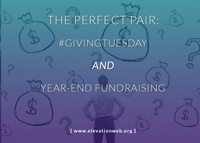As a nonprofit professional, you understand how important it is to build strong donor relationships. However, once you’ve acquired donors, the next challenge is getting them to stick around for the long term. A tried and true way to connect with your donors (and boost your donor retention rate) is to reinforce your relationships through nonprofit storytelling.
Nonprofit storytelling is a popular communication approach that helps you appeal to your donors’ emotions and make them more passionate about your cause. After all, storytelling has always been an important part of how people relate to each other, from ancient traditions to today’s television shows and books. Storytelling can help your donors better understand your nonprofit’s goals and how they can become a part of the solution.
Nonprofit storytelling doesn’t have to be overly complex, but there are a few key features you’ll need to keep in mind. Ultimately, your stories should grab your audience’s attention, explain the problem at hand, and encourage your donors to take action. To develop a compelling story that checks all these boxes, consider these tips:
- Spotlight real people.
- Create a complete story arc.
- Appeal to donors’ emotions.
- Develop a call to action.
- Include engaging visuals.
With effective storytelling, your nonprofit can grow loyal donor relationships, amp up its fundraising efforts, and develop a stronger branding strategy. Let’s begin.
Spotlight real people
Every good story needs compelling characters, but with nonprofit storytelling, your characters will be real people connected to your nonprofit! They might be your nonprofit’s founder, volunteers, or community members that your organization serves.
Every character in your story should serve a specific purpose, so think about the people whose stories would make the biggest impact on your audience in different ways. For example, if you’re a healthcare organization running a virtual fundraising campaign, you can spotlight a patient who benefitted from your services to showcase the impact that your organization’s work has on people’s lives.
Continuing with this example, give a brief biography of the patient and explain the ways your nonprofit supported this person. This can apply to any nonprofit, such as spotlighting a dog that was saved by an animal rescue or even a forest that was preserved because of an environmental nonprofit’s efforts. Your characters don’t always have to be human! But if they are, make sure to ask for permission before including them in your marketing materials.
Characters are a great way to give your audience someone to root for. To add extra impact, choose a character who your audience can relate to. The more they can resonate with your character, the more receptive they will be to your story (and to donating!). Consider all the different reasons why supporters donate to your mission and spotlight characters whose stories relate to those different motivations and desires.
Create a complete story arc
Your story needs a beginning, middle, and end to pique your audience’s interests. Just part of a story won’t be as effective or engaging for audiences, so make sure to include these story elements:
- Exposition. In this section, you’ll lay the groundwork for your story. Introduce the audience to your character(s) and set the scene. Use a strong hook to grab the audience’s attention.
- Conflict. Here’s where you’ll bring attention to the problem at hand. Don’t get too graphic (you don’t want to scare your audience away!), but provide enough details so they can understand the magnitude of the issue. You should also avoid including too many statistics because this will slow your audience down and distract them from your message.
- Rising action. Give more background information into the problem and why it is occurring. If you decide to include one or two statistics, this would be a good place to put them to illustrate the reality of the problem your mission combats.
- Climax. Here, you’ll describe the specific actions your nonprofit takes to solve the problem! Make sure to emphasize how this was made possible through donors’ contributions. This section will give new donors more insight into the work your nonprofit does and will help existing donors connect more with your organization.
- Resolution. This is the part your audience has been patiently waiting for! You’ll describe how your character is doing better than ever because of your nonprofit’s work. Make sure to also include next steps for your audience so they know how to support more people like your character.
As you create your story, make sure to be descriptive, but avoid adding too much fluff. Keep in mind the purpose of your story so you can stay on track. According to Getting Attention’s nonprofit storytelling guide, an effective dramatic arc empowers your audience to play a role in the story, so make your messaging clear to inspire your audience to act.
Once you’ve nailed down your story’s arc, shape it based on the platform you’re sharing it on (email, text campaign, social media, etc.) so it can reach people more effectively. A story can be shorter or longer depending on the context of the communication channel.
For example, if you’re sharing it on Instagram, stick to just a couple of sentences in the caption and make your story more image-based. In contrast, an email gives you more room for lengthy storytelling, but don’t go overboard with it! People should be able to read your story in just a few minutes so they don’t get distracted and click away.
Appeal to donors’ emotions
The goal of your story is to get people to take action, but in order to reach that point, your audience has to feel emotionally moved.
Your story needs to activate empathy in supporters, which can take a little work. Through emotional vocabulary, detailed description, and a story that touches on the lows and the highs, you can successfully evoke emotions in your audience. Here are a few tips to achieve this goal:
- Paint a full picture of your character and the context. If your story feels too abstract or detached, your audience won’t be able to connect. The more concrete details you include, the better. However, don’t get too bogged down in the details; each part of your story should flow naturally so your audience can easily follow along.
- Create an emotional story. Your story shouldn’t target just one emotion. For example, if your story is too sad, your audience might feel compassion fatigue and click away. You need to take your audience through a journey, from the lowest point in your character’s life (as it relates to your nonprofit’s role in helping) to the point where they are now living an improved life. This will help your audience connect with the main character and put themselves in their shoes.
- Be truthful. While you should use descriptive language, avoid overembellishing any information for a dramatic effect. This can lead your audience to distrust your organization and feel discouraged from contributing to its cause. Tell the story as it happened. Interview your constituent, gather impact statistics, and more to fill in all the details you’ll need.
The more powerful a story is, the more it will impact your audience. Choose a memorable story that will stick with your audience for a long time so they continue to want to support your organization.
Develop a call to action
Once you arrive at the resolution of your story, you don’t just want to wrap it up! Appeal directly to your audience by giving them next steps to be a part of the solution. For instance, if your story was about a homeless dog that is now living happily with its new family, explain to your donors that their contributions can save many more lives. Offer a link or donate button that will take your audience to your donation page.
This can apply to yearlong fundraising efforts or even specific fundraising campaigns. With fundraising campaigns, you’ll need a dedicated landing page which can become even more compelling with a story and strong call to action.
For instance, if you’re running a peer-to-peer fundraiser, use a story arc across your various campaign materials to illustrate why you’re running this campaign. Then, end it with a firm call to action on how your supporters can help by creating their own fundraising pages and sharing it with their personal networks. Make sure your next steps are concrete and include any necessary directions so your audience can easily follow through in helping your nonprofit.
Include engaging visuals
To break up long paragraphs of text and keep your audience engaged, you’ll need impactful visuals. These photos or videos should add value to the story and help your audience emotionally connect with the main character and your nonprofit.
A great place to start is with a photo of your character to add credibility to your story and show that this is a real person. This will also tap into your donors’ empathy. If your character underwent a significant transformation, it can be helpful to illustrate this with a before and after photo.
Another great method of storytelling is video. Video can make it easier for a message to come across since readers might get distracted by large blocks of text. Your video can be a sit-down interview with your character, a series of clips showing your nonprofit in action, or even a live-stream to let remote donors feel a part of your community.
According to the OneCause guide to nonprofit live streaming, live videos have quickly become one of the most popular forms of digital video content, giving your nonprofit a great opportunity to expand its reach. There are many different types of content you can create, from live interviews to live-from-the-field style videos where you give donors an immediate look at the work your nonprofit is doing.
There are many free platforms you can use to set up your livestream and easily share your nonprofit’s story with the world. Consider using Facebook Live, Vimeo, or Instagram to reach hundreds, thousands, or even millions of people with your nonprofit to attract donors.
Visuals can work to boost people’s excitement over any fundraising event, whether it’s in-person, virtual, or hybrid. For virtual and hybrid events especially, make sure to use storytelling tactics along with compelling visuals to reinforce strong donor relationships—this will help people better connect with your organization’s mission, even if they live in another city, state, or country.
Wrapping up
As you craft your story, make sure that it’s emotionally compelling and has a strong call to action. Keep in mind your audience and develop a story that will resonate with them and inspire them to give.
Once you have a solid story arc, it should be shaped to fit the communication channel you’re sharing it on—whether that’s a visual social media platform like Instagram or an email. You can accomplish a lot of storytelling in a couple of sentences and with a powerful photo, or you can tell the story in a longer message—this all depends on the context of the communication channel and your goals.
Nonprofit storytelling is an effective tool to connect with new and existing donors, so make this a regular part of your communication strategy to maximize support.



